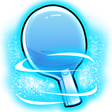Friendship 729
General
Filippo Rotunno Asked 16 years ago
I have for years used on my b/hand a 1.5 mm JO Waldner rubber. As an experiment I have changed it with a 2 mm Chinese Friendship 729 rubber. As a first reaction the bat is slightly heavier. However when using it I found that I was able to play attacking shots with more freedom. It is also better when blocking. On a negative I seem to have lost some of the control as the rubber seems to be possessed by evil spirits and does what it wants to do. In pushing and serving it does not seem to generate as much spin as the JO Waldner rubber. Now come the questions. What is your take on this rubber or Chinese rubbers in general? Is there a more modern rubber that I could use instead of the outdated Friendship? Should I persevere with it? Kind regards Filippo
 Alois Rosario Answered 16 years ago
Alois Rosario Answered 16 years ago
Hi Filippo,
The old Friendship is still a good rubber. It does tend to be a little heavy but allows you to generate good spin.
I think Chinese rubbers with a tack surface are suited to players who brush over the ball with their swing and like a high throw.
It really is a matter of preference and what feels right for you here.
The XIOM Omega III Asian sponge rubbers are very good.
Thoughts on this question
Become a free member to post a comment about this question.
Ji-Soo Woo Posted 16 years ago
Excuse me Alois
I was wondering if you could just clarify your comment on tacky Chinese rubbers suiting players who like to brush over the ball with their swing.
I thought ALL players using any inverted rubber (Chinese or otherwise) were supposed to brush over the ball with their topspin swings. So if you use a non-tacky (or less tacky) European/Japanese rubber, does that mean you are not supposed to brush over the ball? What could of swing would you use then?
thanks
Ji-Soo
Lionel Unknown Posted 16 years ago
Ji Soo, Alois,
If I understand Alois correctly, the techniques to play a typical tacky topsheet Chinese rubber, and play a Euro/Jap grippy (but not tacky) topsheet rubber during top spin are actually different.
For Chinese rubber, the more appropriate technique is called "BRUSH-friction-Spin", it means, if we count by percentage of how much "knocking" and how much of "friction-brush", "friction-brush" may consist of >75% of the strength, whereas 25% of the strength goes to "knocking". In this way, the ball does not sink deep into the sponge, and the ball-wrapping effect by the topsheet is not important. It is the tacky topsheet which catches the ball and spin it. In another easier descriptive word, we call this "TOPSHEET SPIN".
For Euro/Jap rubber, it is another aspect of spin, the technique is called "knocking-friction-spin". It means, more percentage of the arm swing must first "knock" the ball to get the ball sinks into the sponge, so that there is a ball-wrapping effect from the topsheet. This "knocking" will ensure the ball is having a big surface to be warpped by the topsheet. Then the arm swing will complete by "friction-brush", to put spin into the ball. This effect to be summarized by another easier term "MECHANICAL SPIN".
Ji-Soo Woo Posted 16 years ago
Hi Lionel
Thanks for the interesting information. I had heard about European rubbers being more about mechanical spin and Chinese rubbers being more tacky...so I guess it makes sense then that you would need to graze the ball more with Chinese rubbers, and need to make more solid contact with European rubbers.
Whenever you see demonstrations of topspin shots, it doesn't differentiate between the two types of rubbers. If there is a material difference in the stroke needed for tacky versus mechanical spin rubbers, it would be fascinating to see a demonstration of both side by side to see the difference.